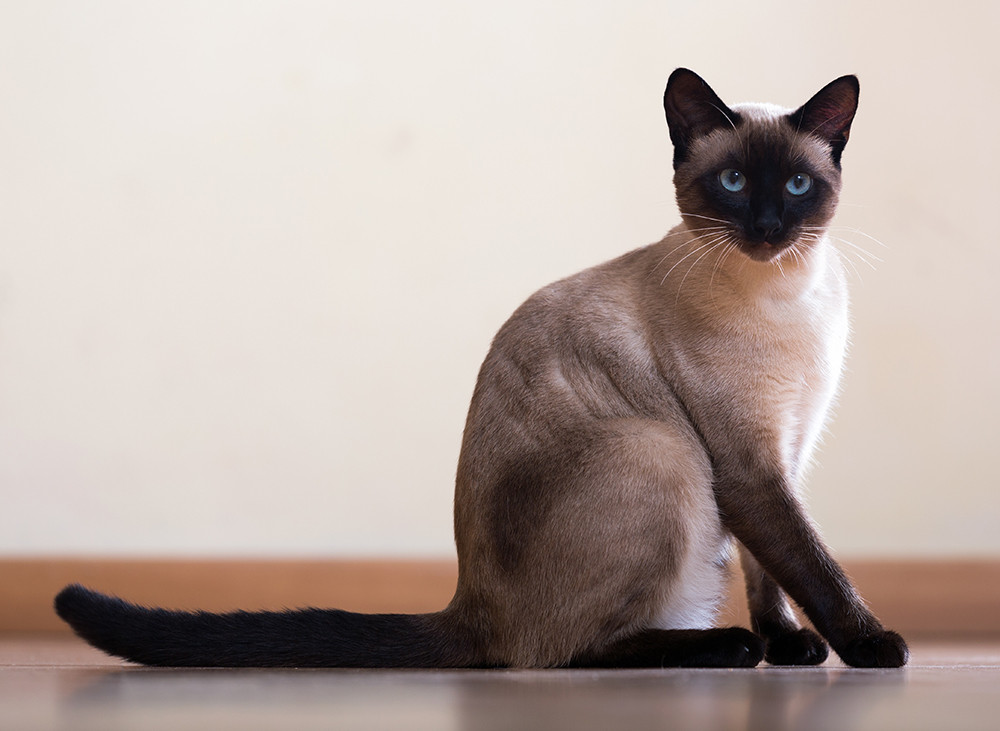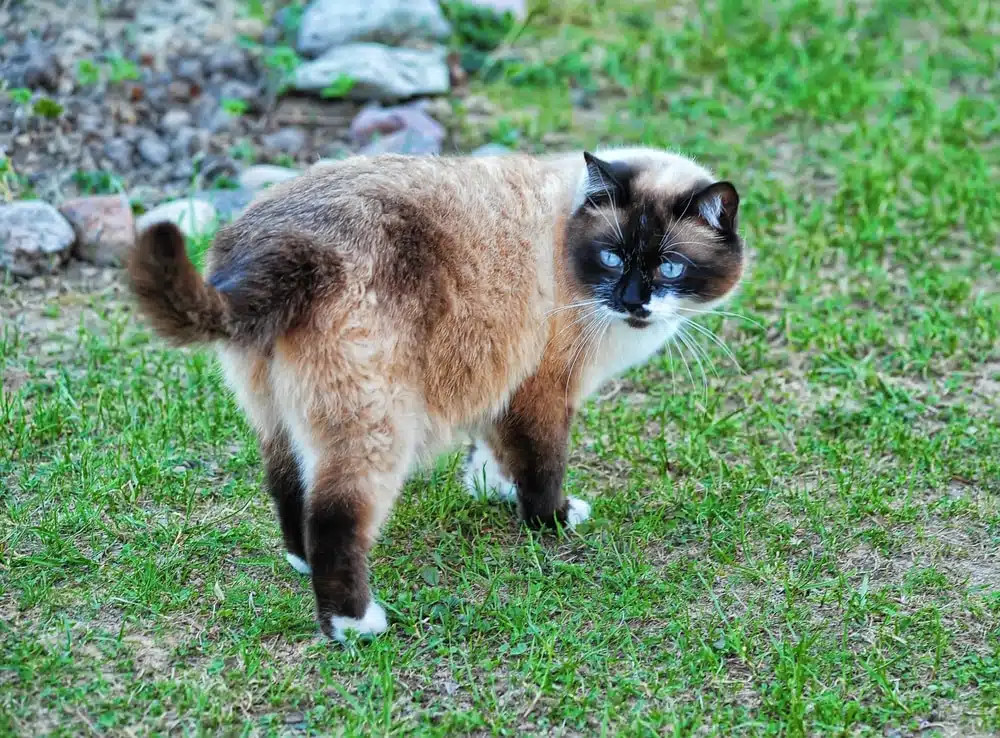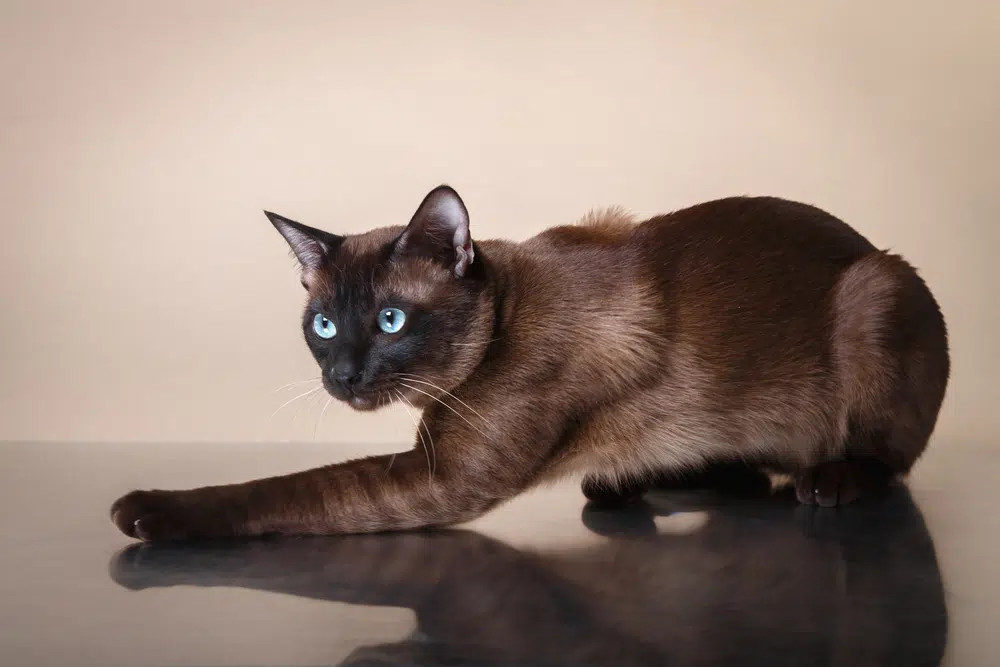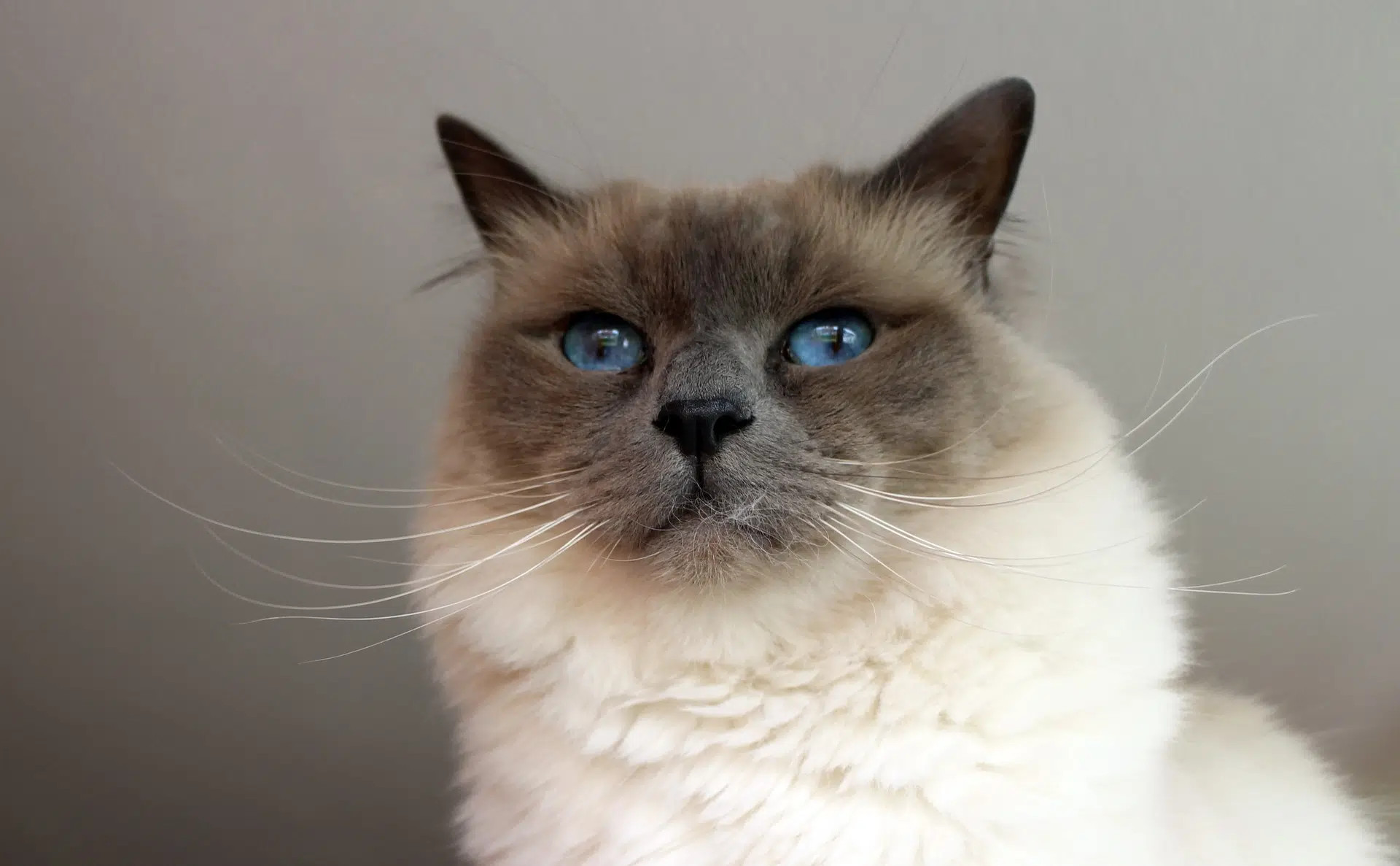Blue-eyed cats hold a special allure, captivating cat enthusiasts with their striking sapphire orbs. While a common myth links blue eyes and deafness in white cats, the reality is more nuanced. Not all blue-eyed felines are white, and not all white, blue-eyed cats experience hearing loss. The spectrum of blue-eyed cat breeds is surprisingly diverse, each with unique characteristics and charm.
For those enchanted by icy-blue eyes, this guide explores eight captivating blue-eyed cat breeds, along with fascinating facts to deepen your appreciation for these mesmerizing felines.
The Alluring Lineup: 8 Blue-Eyed Cat Breeds
1. Siamese: The Iconic Blue-Eyed Communicator
 Siamese cat with striking blue eyes sitting indoors
Siamese cat with striking blue eyes sitting indoors
Image Credit: BearFotos, Shutterstock
| Feature | Description |
|---|---|
| Origin: | Thailand |
| Lifespan: | 15 years |
| Weight: | 10 to 15 pounds |
The Siamese cat is perhaps the most recognized blue-eyed breed, gracing popular culture in films like Lady and the Tramp and Meet the Fockers. Originating from Thailand, these cats were once revered for their elegant appearance and distinctive pointed coats, which beautifully contrast with their vivid blue eyes.
Beyond their stunning looks, Siamese cats are known for their energetic, intelligent, and intensely curious nature. They thrive on interaction with their human families, forming strong bonds and often expressing their affection vocally. Be prepared for engaging “conversations” and the occasional midnight serenade, as Siamese cats are known for their talkative personalities and desire for attention.
2. Turkish Angora: Ancient Elegance with Heavenly Eyes
Image Credit: Andrei Armiagov, Shutterstock
| Feature | Description |
|---|---|
| Origin: | Central Anatolia (modern Turkey) |
| Lifespan: | 12 to 18 years |
| Weight: | 5 to 10 pounds |
The Turkish Angora boasts a history stretching back millennia, originating from the mountainous regions of Turkey. Legend whispers of these cats as companions to deities, their eyes believed to mirror the heavens. While Turkish Angoras can display a range of eye colors, including green and amber, blue eyes are a hallmark of the breed, and some even exhibit heterochromia, with eyes of different colors.
Characterized by their playful, affectionate, and generally good-natured temperament, Turkish Angoras are delightful companions for families and individuals alike. They are inquisitive explorers, enjoying interactive play and requiring ample opportunities to climb, scratch, and survey their domain. Their athletic prowess means providing vertical space with cat trees and shelves is essential to satisfy their energetic nature and prevent boredom-related mischief.
3. Ragdoll: The Gentle Giant with Puppy-Dog Eyes
 Blue point Ragdoll cat with classic blue eyes
Blue point Ragdoll cat with classic blue eyes
Image Credit: cath5, Shutterstock
| Feature | Description |
|---|---|
| Origin: | California, United States |
| Lifespan: | 12 to 15 years |
| Weight: | 8 to 15 pounds |
The Ragdoll, a relatively modern breed developed in California, is renowned for its striking blue eyes and exceptionally docile and gentle personality. Originating from a Persian breeder’s efforts to create the perfect lap cat, Ragdolls are aptly named for their tendency to go limp and relaxed when held, much like a rag doll.
These blue-eyed beauties are ideal companions for those seeking a calm and affectionate feline friend. Ragdolls thrive on human companionship, happily lounging on laps and snuggling on couches. While they enjoy quiet affection, they also appreciate gentle play and exploring their surroundings, making them adaptable to various home environments.
4. Balinese: The Longhaired Siamese with a Melodious Voice
 Elegant Balinese cat perched on a tree branch
Elegant Balinese cat perched on a tree branch
Image Credit: Fazlyeva Kamilla, Shutterstock
| Feature | Description |
|---|---|
| Origin: | United States |
| Lifespan: | 7 to 15 years |
| Weight: | 5 to 8 pounds |
The Balinese cat is essentially a long-haired version of the Siamese, arising from a spontaneous genetic mutation within Siamese lines. Recognized for their rarity by the American Cat Fanciers Association, Balinese cats inherit the striking blue eyes and pointed coat of their Siamese ancestors, complemented by a flowing, silky coat.
Balinese cats are known for their adaptability and sociability, fitting seamlessly into diverse households, from single individuals to families with children and other pets. They are intelligent and communicative, readily expressing their needs and desires to their human companions. While playful and engaging, Balinese cats also possess a relaxed side, enjoying quiet moments with their families.
5. Snowshoe: The Rare Beauty with Snowy Paws
 Snowshoe cat with distinctive white paws in green grass
Snowshoe cat with distinctive white paws in green grass
Image Credit: Anna Krivitskaya, Shutterstock
| Feature | Description |
|---|---|
| Origin: | United States, 1960s |
| Lifespan: | 14 to 20 years |
| Weight: | 7 to 14 pounds |
Snowshoe cats are a less common breed, often mistaken for Siamese due to their similar pointed coloration and blue eyes. Their name originates from their distinctive white paws, contrasting beautifully with their darker bodies.
The Snowshoe’s captivating appearance, combining striking blue eyes with a creamy body and darker points, is truly eye-catching. Like Siamese cats, Snowshoes are vocal and communicative, enjoying “conversations” with their families. They are also known for their affectionate and playful nature, making them wonderful family pets.
6. Tonkinese: The Playful Blend with Aqua Eyes
 Tonkinese cat with mesmerizing aqua blue eyes resting on a beige surface
Tonkinese cat with mesmerizing aqua blue eyes resting on a beige surface
Image Credit: dezy, Shutterstock
| Feature | Description |
|---|---|
| Origin: | Asia |
| Lifespan: | 15 to 20 years |
| Weight: | 6 to 12 pounds |
The Tonkinese is a delightful blue-eyed breed often overlooked despite their charming personalities. A hybrid breed resulting from crossing Siamese and Burmese cats, Tonkinese cats inherit the best traits of both, including captivating blue to aqua eyes and playful, affectionate temperaments.
While their exact origin is debated, the first recognized Tonkinese, Wong Mau, appeared in the 1930s, suggesting an Asian origin. Tonkinese cats are outgoing and sociable, readily interacting with family members and even welcoming visitors. They are intelligent and enjoy interactive games and puzzle toys, thriving on mental and physical stimulation. Known for their independent streak, they can also entertain themselves when alone, making them adaptable companions.
7. Birman: The Sacred Cat of Burma with Sapphire Gaze
 Close-up portrait of a Birman cat showcasing its bright blue eyes
Close-up portrait of a Birman cat showcasing its bright blue eyes
Image Credit: Antranias, Shutterstock
| Feature | Description |
|---|---|
| Origin: | Northern Burma |
| Lifespan: | 9 to 15 years |
| Weight: | 7 to 12 pounds |
The Birman, often called the “Sacred Cat of Burma,” is a pointed breed distinguished by its long, luxurious coat, striking blue eyes, and unique white “mittens” on their paws. Coming in various pointed colors, Birmans share a gentle and sweet temperament, often described as shy yet playful when comfortable.
While Birman cats are vocal, their meows are typically softer and less demanding than some other vocal breeds. Their long coats require regular brushing to prevent tangles and minimize shedding, but their affectionate nature and captivating blue eyes make them rewarding companions.
8. Javanese: The Energetic and Playful Blue-Eyed Companion
 Javanese cat with striking blue and green heterochromia eyes
Javanese cat with striking blue and green heterochromia eyes
Image Credit: vistawei, Pxhere
| Feature | Description |
|---|---|
| Origin: | North America |
| Lifespan: | 10 to 15 years |
| Weight: | 5 to 12 pounds |
The Javanese cat is closely related to the Siamese, sharing a similar elegant appearance and striking blue eyes. They possess a long, silky coat without an undercoat, giving them a sleek and refined look.
Javanese cats are known for their high energy levels and playful personalities, requiring ample stimulation through interactive play, toys, and climbing structures. While independent enough to spend time alone, they crave attention and companionship, thriving in homes where they receive regular interaction and engagement. If you seek a lively and playful blue-eyed feline, the Javanese might be your perfect match.
Decoding the Mystery: 3 Fascinating Facts About Blue-Eyed Cats
Delve deeper into the captivating world of blue-eyed cats with these intriguing facts:
1. The Pigment Puzzle: Why Blue Eyes?
Blue eyes in cats are less common compared to other eye colors and are primarily a result of a lack of pigmentation. The pointed coat coloration, seen in breeds like Siamese and Ragdolls, is linked to a form of albinism that can result in blue eyes. In white cats with blue eyes, a specific gene inhibits pigment production in both their coat and eyes.
2. The Deafness Connection: Unraveling the Link
Deafness, particularly in white cats with blue eyes, is a recognized phenomenon. The genes responsible for the lack of pigmentation can sometimes also affect the development of the inner ear. Statistics show that a significant percentage of white cats with blue eyes experience deafness. While the exact percentages vary, it’s important to be aware of this potential link, especially when considering a white, blue-eyed cat. However, it’s crucial to remember that not all blue-eyed cats, and certainly not all blue-eyed breeds, are predisposed to deafness. The risk is highest in white cats.
3. Kitten Blues: A Universal Starting Point
Image Credit: dezy, Shutterstock
Interestingly, all kittens are born with blue eyes. This is because pigment production in their eyes is delayed after birth. It typically takes around 6 weeks for their permanent eye color to develop. If a kitten’s eyes remain blue beyond 8 weeks, it’s a strong indication that they will retain their beautiful blue eyes into adulthood.
Frequently Asked Questions About Blue-Eyed Cats
Navigating the world of blue-eyed cats can bring up some common questions. Let’s address a few:
Are Blue-Eyed Cats Hypoallergenic?
Unfortunately, blue eyes are not linked to hypoallergenic qualities. The primary cat allergen, Fel d 1 protein, is produced at similar levels by blue-eyed cats as by cats with other eye colors. Hypoallergenic cats are those that produce lower levels of Fel d 1, regardless of their eye color. This protein is found in dander, saliva, and urine, triggering allergic reactions in sensitive individuals.
Do Blue-Eyed Cat Breeds Need Special Care?
Generally, blue-eyed cats do not require specialized care beyond the typical needs of any cat breed. Unless a blue-eyed cat is also white and deaf, their blue eye color itself does not necessitate extra healthcare. Regular grooming, nail trimming, a balanced diet, and plenty of affection are the cornerstones of caring for any cat, including those with captivating blue eyes.
Are Blue-Eyed Cat Breeds More Expensive?
Yes, certain blue-eyed cat breeds can be more expensive, especially when acquired from reputable breeders. This higher cost can be attributed to several factors. Firstly, blue eyes are considered a desirable and relatively rarer trait in many cat breeds. Secondly, breeds with blue eyes often possess other sought-after characteristics, such as long, luxurious coats or distinctive breed-specific traits. Furthermore, responsible breeding programs focused on preserving specific lineages and traits, including blue eyes, can contribute to higher prices.
 Decorative paw print divider
Decorative paw print divider
Final Thoughts: Embracing the Blue-Eyed Cat Charm
The world of blue-eyed cats is rich and diverse, offering a spectrum of breeds, each with unique personalities and captivating sapphire eyes. When choosing a blue-eyed feline companion, prioritize compatibility and lifestyle fit over breed alone. Consider the cat’s temperament, energy level, and care needs to ensure a harmonious and loving partnership. Whether you are drawn to the talkative Siamese, the gentle Ragdoll, or any other blue-eyed breed, these enchanting cats promise to bring beauty and joy to your life.
See also:
Sources
Featured Image Credit: oussama el biad, Shutterstock

